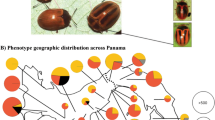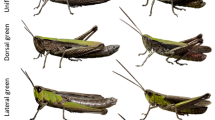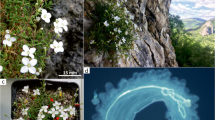Abstract
Colonies of Pocillopora spp. containing the crab Trapezia digitalis were collected from Hawaii in summer of 1979 and of 1980. Individuals of T. digitalis in Hawaii vary extensively in coloration of the carapace: crabs were separated into phenotypic classes by their degree of carapace reticulation. When presented with two females of different phenotype, males preferentially paired with the female which was similar to them in reticulation. The genetic population structure of T. digitalis was unusual by comparison with other species of Trapezia. Previously reported homozygote excesses at esterase-4, hexokinase-1, phosphoglucoseisomerase, and general protein-2 cannot be explained by the single-locus Wahlund effect, since there was not significant genetic differentiation among phenotypic classes, as measured by Wright's F ST statistic. There was significant variation among classes in allele frequencies at a fifth locus, hexokinase-2. Two pairs of loci were in significant gametic disequilibrium. Gametic disequilibrium was not detected in seven other species of Trapezia. It is suggested that multi-locus genetic analysis and an increased geographic sampling range are needed to determine the genetic population structure of T. digitalis in relation to observed variation in coloration.
Similar content being viewed by others
Literature cited
Abele, L. G. and W. K. Patton: The size of coral heads and the community biology of associated decapod crustaceans. J. Biogeogr. 3, 35–47 (1976)
Allard, R. W.: The mating system and microevolution. Genetics, Austin, Tex. 79 (Suppl.), 115–126 (1975)
Baker, M. C., D. B. Thompson, G. L. Sherman, M. A. Cunningham and D. F. Tomback: Allozyme frequencies in a linear series of song dialect populations. Evolution, Lawrence, Kansas 36, 1020–1029 (1982)
Banner, A. H.: Kaneohe Bay, Hawaii: urban pollution and a coral reef ecosystem. Proc. 2nd int. Symp. coral Reefs 2, 685–702 (1974). (Ed. by A. M. Cameron et al. Brisbane: Great Barrier Reef Committee)
Banner, A. H. and J. H. Bailey: Effects of urban pollution upon a coral reef system. A preliminary report. Tech. Rep. Hawaii Inst. mar. Biol. 25, 1–66 (1970). (Limited distribution; copies available from: Institute of Marine Biology, Technical Library, P. O. Box 1346, Kaneohe, Hawaii 96744, USA)
Barry, C. K.: Ecological study of the decapod crustaceans commensal with the branching coral Pocillopora meandrina var. nobilis Verrill, 64 pp. M. S. thesis, University of Hawaii, Honolulu 1965
Brown, A. D. H.: Sample sizes required to detect linkage disequilibrium between two or three loci. Theor. Popul. Biol. 8, 184–201 (1975)
Brown, A. H. D., M. W. Feldman and E. Nevo: Multilocus structure in natural populations of Hordeum spontaneum. Genetics, Austin, Tex. 96, 523–536 (1980)
Brussard, P. F.: Geographic patterns and environmental gradients: the central-marginal model in Drosophila revisited. A. Rev. Ecol. Syst. 15, 25–64 (1984)
Cannings, C. and A. W. F. Edwards: Expected genotypic frequencies in a small sample: deviation from Hardy-Weinberg equilibrium. Am. J. hum. Genet. 21, 245–247 (1969)
Castro, P.: Brachyuran crabs symbiotic with scleractinian corals: a review of their biology. Micronesica 12, 99–110 (1976)
Castro, P.: Notes on symbiotic decapod crustaceans from Gorgona Island, Columbia, with a preliminary revision of the eastern Pacific species of Trapezia (Brachyura, Xanthidae), symbionts of scleractinian corals. An. Ins.t Invest. mar. Punta de Betin 12, 9–17 (1982)
Chakraborty, R.: Detection of nonrandom association of alleles from the distribution of the number of heterozygous loci in a sample. Genetics, Austin, Tex. 108, 719–731 (1984)
Coles, S. L.: Colonization of Hawaiian reef corals on new and denuded substrata in the vicinity of a Hawaiian power station. Coral Reefs 3, 123–130 (1984)
Conover, W. J.: Practical nonparametric statistics, 462 pp. New York: John Wiley & Sons 1971
Eanes, W. F. and R. K. Koehn: An analysis of genetic structure in the monarch butterfly, Dannaus plexippus L. Evolution, Lawrence, Kansas 32, 784–797 (1978)
Finney, W. C. and L. G. Abele: Allometric variation and sexual maturity in the obligate coral commensal Trapezia ferruginea Latreille (Decapoda, Xanthidae). Crustaceana 41, 113–130 (1981)
Gillespie, J. H.: The role of migration in the genetic structure of populations in temporally and spatially varying environments. I. Conditions for polymorphism. Am. Nat. 109, 127–135 (1975)
Halliday, T. R.: Sexual selection and mate choice. In: Behavioural ecology, pp 180–213. Ed. by J. R. Krebs and N. B. Davies. Oxford: Blackwell Scientific 1978
Hastings, A.: Linkage disequilibrium, selection, and recombination at three loci. Genetics, Austin, Tex. 106, 153–164 (1984)
Hedgecock, D.: Genetic consequences of larval retention: theoretical and methodological aspects. In: Estuarine comparisons, pp 553–568. Ed. by V. S. Kennedy. New York: Academic Press 1982
Hedrick, P., S. Jain and L. Holden: Multilocus systems in evolution. Evolutionary Biol. 11, 101–184 (1978)
Hill, W. G.: Estimation of linkage disequilibrium in randomly mating populations. Heredity, Lond. 33, 229–239 (1974)
Hill, W. G.: Tests for association of gene frequencies at several loci in random mating diploid populations. Biometrics 31 881–889 (1975)
Huber, M. E.: Ethology and population biology of Trapezia, a xanthid crab symbiotic with reef corals, with special reference to territoriality and speciation, 459 pp. Ph. D. thesis, Scripps Institution of Oceanography, La Jolla, California 1983
Huber, M. E.: Population genetics of eight species of Trapezia (Brachyura: Xanthidae), symbionts of corals. Mar. Biol. 85, 23–36 (1985a)
Huber, M. E.: Nonrandom mating with respect to mate size in the crab Trapezia (Brachyura, Xanthidae). Mar. Behav. Physiol. 12, 19–32 (1985b)
Huber, M. E. and S. L. Coles: Resource utilization and competition among the five Hawaiian species of Trapezia (Brachyura: Xanthidae). Mar. Ecol. Progr. Ser. 30, 21–31 (1986)
Jain, S. K. and R. W. Allard: The effects of linkage, epistasis and inbreeding on population changes under selection. Genetics, Austin, Tex. 53, 633–659 (1966)
Johannes, R. E.: Pollution and degradation of coral reef communities. In: Tropical marine pollution, pp 13–51. Ed. by E. J. Ferguson Wood and R. W. Johannes. Amsterdam: Elsevier 1975
Jokiel, P. L. and S. L. Coles: Effects of heated effluent on hermatypic corals at Kahe Point, Oahu. Pacif. Sci. 28, 1–18 (1974)
Kendall, M. G. and B. Babington-Smith: The problem of m rankings. Ann. math. Statist. 10, 275–287 (1939)
Latreille, P. A.: Entomologie, ou histoire naturelle des crustacés, des arachnides, et des insects. Encycl. méth. Hist. nat. 10, 1–832 (1825)
Li, W. and M. Nei: Stable linkage disequilibrium without epistasis in subdivided populations. Theor. Popul. Biol. 6, 173–183 (1974)
Makela, M. E. and R. H. Richardson: The detection of sympatric sibling species using genetic correlation analysis. I. Two loci, two gamodemes. Genetics, Austin, Tex. 86, 665–678 (1977)
Maragos, J. E.: A study of the ecology of Hawaiian reef corals, 290 pp. Ph.D. thesis, University of Hawaii, Honolulu 1972
Neel, J. V. and R. H. Ward: The genetic structure of a tribal population, the Yanomama Indians. VI. Analysis by F-statistics (including a comparison with the Makiritare and Xavante). Genetics, Austin, Tex. 72, 639–666 (1972)
Nei, M. and W. Li: Linkage disequilibrium in subdivided populations. Genetics, Austin, Tex. 75, 213–219 (1973)
Odinetz, O. M.: L'éthologie au service de la systématique: l'example des Trapezia (Crustacés, Decapodes, Brachyoures). Oceanis (Paris) 10, 123–130 (1984)
O'Donald, P.: Genetic models of sexual selection, 250 pp. Cambridge: Cambridge University Press 1980a
O'Donald, P.: Sexual selection by female choice in a monogamous bird: Darwin's theory corroborated. Heredity, Lond. 45, 201–217 (1980b)
Patton, W. K.: Community structure among the animals inhabiting the coral Pocillopora damicornis at Heron Island, Australia. In: Symbiosis and the sea, pp 219–243. Ed. by. W. B. Vernberg. Columbia: University of South Carolina Press 1974
Preston, E. M.: Niche overlap and competition among five sympatric congeneric species of xanthid crabs, 125 pp. Ph. D. thesis, University of Hawaii, Honolulu 1971
Preston, E. M.: A computer simulation of competition among five sympatric congeneric species of xanthid crabs. Ecology 54, 469–483 (1973)
Searcy, W. A.: The evolutionary effects of mate selection. A. Rev. Ecol. Syst. 13, 57–85 (1982)
Serène, R.: Observations on species of the group Trapezia rufopunctata-maculata, with a provisional key for all the species of Trapezia. J. mar. biol. Ass. India 11, 126–148 (1969)
Snedecor, G. and M. R. Irwin: On the chi-square test for homogeneity. Iowa St. J. Sci. 8, 75–81 (1933)
Sokal, R. R. and F. J. Rohlf: Biometry. The principles and practice of statistics in biological research, 776 pp. San Francisco: W. H. Freeman & Co 1969
Spielman, R. S., J. V. Neel and F. H. F. Li: Inbreeding estimation from population data: models, procedures, and implications. Genetics, Austin, Tex. 85, 355–371 (1977)
Spiess, E. B.: Genes in populations, 780 pp. New York: John Wiley & Sons 1977
Wallace, B.: Basic population genetics, 688 pp. New York: Columbia University Press 1981
Weir, B. S. and C. C. Cockerham: Testing hypotheses about linkage disequilibrium with multiple alleles. Genetics, Austin, Tex. 88, 633–642 (1978)
Weir, B. S. and C. C. Cockerham: Estimating F-statistics for the analysis of population structure. Evolution Lawrence, Kansas 38, 1358–1370 (1984)
Wright, S.: Evolution in Mendelian populations. Genetics, Princeton 16, 97–159 (1931)
Wright, S.: The interpretation of population structure by F-statistics with special regard to systems of mating. Evolution, Lawrence, Kansas 19, 395–420 (1965)
Wright, S.: The origin of F-statistics for describing the genetic aspects of population structure. Monogr. Popul. Genetics 3, 3–26 (1973). (Honolulu: University of Hawaii Press)
Zouros, E., B. Golding and T. F. C. MacKay: The effect of combining alleles into electrophoretic classes on detecting linkage disequilibrium. Genetics, Austin, Tex. 85, 543–556 (1977)
Author information
Authors and Affiliations
Additional information
Communicated by R. S. Carney, Baton Rouge
Rights and permissions
About this article
Cite this article
Huber, M.E. Phenotypic assortative mating and genetic population structure in the crab Trapezia digitalis . Mar. Biol. 93, 509–515 (1987). https://doi.org/10.1007/BF00392788
Accepted:
Issue Date:
DOI: https://doi.org/10.1007/BF00392788




